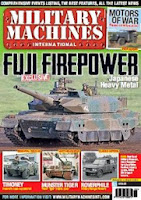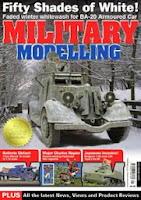Wednesday, January 1, 2014
Military Machines International 02/2014
The exhibits of the Deutsches Panzermuseum Munster include almost all major German WW2 tank and armoured fighting vehicle designs. Among them are some pretty rare vehicles, including a Sturmtiger assault mortar, one of only two still in existence, and an example of the Tiger II, but from the day the Deutsches Panzermuseum Munster opened its doors to the public in September 1983 one vehicle was missing from its collection, the Panzerkampfwagen VI Tiger I Ausführung E Sd.Kfz. 181. Worldwide the Tiger I is probably the best known tank ever built in Germany and therefore the Deutsches Panzermuseum Munster considered the lack of a Tiger I quite a gap in its collection. Since April 2013 a privately owned Tiger I has been on loan to the museum, a loan that will see the Tiger displayed until at least 2016, thus closing the gap in the collection for the time being. Previously experts had agreed that only six out of the total of 1,355 Tiger I's built between 1942 and 1944 had survived. One is on display at the Bovington Tank Museum, having been captured by British forces in Tunisia in April 1943, another Tiger I captured by Allied forces is on display at the National Armor and Cavalry Museum at Fort Benning, Georgia in the USA, two survivors can be found in Russia, one of them at Kubinka, the other at the Military Historical Museum in Lenino-Snegiri, and finally two Tiger I are located in France, one at the Musée des Blindés in Saumur, while the other serves as a monument in the outskirts of Vimoutiers in Normandy.
Airfix Model World 02/2014
As I write this I am still looking through my Telford stash - yes, honestly - and looking over notes I took following conversations we had with visitors to the Key stand. Of course, there are always a few who don't like anything the kit manufacturers make or plan to release. I heard comments like, 'Why aren't Airfix making this?' or 'What's the point in another one of those...?' I'm sure some of the other kit companies heard the same range of comments, too. I heartily agree that recent prices from some of the Japanese companies are enough to make you flinch - even though, in my world, you can never have enough F-4EJs in special markings. But at the end of the day it's all down to personal choice and how you want to spend your money, isn't it? And Telford is about having a good time with friends and colleagues - and stocking up on kits. This year represents some significant anniversaries, such as the beginning of World War One and D-Day. I hope that many of you will not only build something from these events, but also take time to read about both of these battles. A little initial knowledge and reading can become a lifelong interest, which can take one who knows where?
The Armourer Magazine 01/02 2014
New Year's Eve 1918. After four long years of war servicemen from the Isle of Lewis in the Outer Hebrides were on their way home, some for the first time .since 1914. Many English soldiers had been granted leave that Christmas but for the Scots, Hogmanay was the time when thoughts turned to home most strongly. When war broke out the islanders had done their duty, every second man from Lewis joining the Army, Royal Navy or Merchant Marine. And they had paid a heavy price. Since 1914 more than 800 had given their lives at various battlefronts on land and sea. Now these survivors were nearing the end of their long journey as they arrived at the railhead at the Kyle of Lochalsh ready to board ships for the last leg - the sailing to Stornoway. But there was a problem; so many men could not be accommodated on the usual transport, the mail boat SS Sheila, so HMY Maire, the yacht belonging to the naval base HMS Maire on Stornoway, was sent to carry the remainder. Its captain, Commander Mason, had a problem getting into the harbour and what was later described as {a bit of blundering', resulted in the yacht striking the pier. Apparently the Iolaire was not an easy ship to turn.
Military Modelling Vol.44 No.01
The Broneavtomobil 20(BA-20) was a 2.5-ton light armoured car developed in the Soviet Union in 1934 and was produced until 1942. The BA-20 was armed with a 7.62mm DT machine gun and had a top road speed of 53mph. Over 4,500 of these vehicles were produced in the 8-year period. The armoured car was designed primarily for reconnaissance and scouting purposes. By 1938, the upgraded BA-20M communication version was introduced which was essentially same vehicle but with a whip-style antenna instead of the external frame antenna. The BA-20 was conceived using the chassis from the civilian GAZ-M1, which in turn, was a modified version of a Ford design. While the chassis was made by the Nizhny Novgorod factory, the body was built at the Vyksinskiy plant where the final assembly of the BA-20 occurred. An interesting feature of the BA-20 and BA-20M was the design of the tyres that were filled with cork so that it was impervious to bullets and shrapnel. Another later modification was the BA-20ZhD which was designed to travel on railway tracks by replacing the wheels with metal rail-type wheels. The BA-20 first saw combat during the Spanish Civil War serving with the Republican Army. They were also pushed into Russian combat service against Japan in 1939 during the Battle of Khalkin Gol. In 1939, the Red Army used large numbers of BA-20s in the invasion of Poland and also during the winter war against Finland circa 1939-40. Many BA-20s were captured by the Finns and pushed into service against the Red Army.
Electric Flight 02/2014
Finishing a model airplane is usually thought of as the last two or three steps needed to be done before your model is ready to fly. In reality, no amount of "finishing" work during J the last few steps can make up for a poor building job. A proper finish should be your ultimate goal throughout the entire building process, not just an afterthought thrown in at the end. The finishing process can often take longer than the initial framing out. My most recent project was a Hall Bulldog and it required a high-gloss finish, so most of the work was done in preparing the various model surfaces for paint. Building the Bulldog was almost a side show. Generally, matte finishes are more forgiving when it comes to surface imperfections. They may be seen under certain lighting conditions, but glossy finishes show everything and are very unforgiving. I built the Bulldog using so-called conventional construction methods — balsa sheeting for metal areas and fabric covering over open framework plywood and balsa. No matter how hard you try. balsa sheeting will eventually show grain due to expansion and contraction if it is filled and finished without first being stabilized. While there are other methods, I use fiberglass cloth and resin to stabilize balsa surfaces. Although I have used both epoxy and polyester resin systems to affix fiberglass, such methods can get heavy in a hurry. For my smaller and mid-size models. I have settled on using water-based varnish (satin Minwax Polycrylic) to apply the fiberglass. This system does not yield as hard of a surface as with a two-part resin, but it is close, and it's a lot lighter. The steps I employ after the glass treatment firm up the surfaces even more.
Model Airplane International 01/2014
The box artwork is OK, but this undersells the contents of the decent sized box, brim full with individually bagged sprues, foam protecting delicate parts and separate boxings for the fuselage etc., superb. Also supplied is a full complement of weapons and full length engines that have (on the most part) redundant exterior detail. The wings have separate slats and flaps, and there are three decal sheets. Photo-etched parts are employed for the radar, which isnt a major selling point of the kit, unlike the seat harnesses, canopy rails and mirrors, which are. These add that extra level of detail often missing in such a release. The sixteen-page book style instructions are well illustrated and give an encouraging reassurance to the build process (being quite involved - spread over 23 steps) to complete the model with its high parts count. First impressions? Goodness, Gracious, Great Balls Of Fire..., it's time to press play on that' soundtrack! But there are some blemishes to attend to. There is a slight seam line down the centre of the clear canopy (as well as the raised moulded detonation chord) and the tyres are vinyl! One more point to highlight is the abundance of rivet detail on the wings - which is going to be down to personal preference how you deal with them, or not.
Subscribe to:
Comments (Atom)





